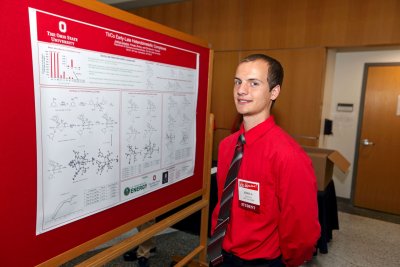SSRP Abstract
Ti/Co Early-Late Heterobimetallic Complexes
 Student: Josh Queener ’20
Student: Josh Queener ’20
Research Mentor: Christine Thomas (The Ohio State University Department of Chemistry and Biochemistry)
Bimetallic complexes have been of increasing interest in the literature thanks to their ability to have different reactivities than the analogous monometallic compounds1. Hetero-bimetallic complexes have become an area of high interest as the different metal centers can produce a synergistic effect improving catalytic activity. These bimetallic compounds are being studied in search of a catalyst that has reactivity comparable to the noble metals like Pd and Pt. The latter metals are considered some of the best metals for catalysis, but it is expensive and may not offer the selectivity that the bimetallic systems can. Multiple new Ti/Co bimetallic compounds were synthesized. These compounds were compared to similar Zr/Co complexes previously characterized. The compounds were characterized by NMR and X-Ray crystallography. The Ti/Co compounds showed noticeable different reactivity from the Zr/Co system. The compounds will be tested for reactivity with various catalytic substrates. The current results show little to no use in one electron transfer reactions.
Chemical processes are at the center of most industrial processes. The compounds that give the best performance are often noble metal based, meaning they include expensive metals like platinum. Our focus was to create new chemical compounds using cheaper metals as the base, that could potentially replace the more expensive compounds.
